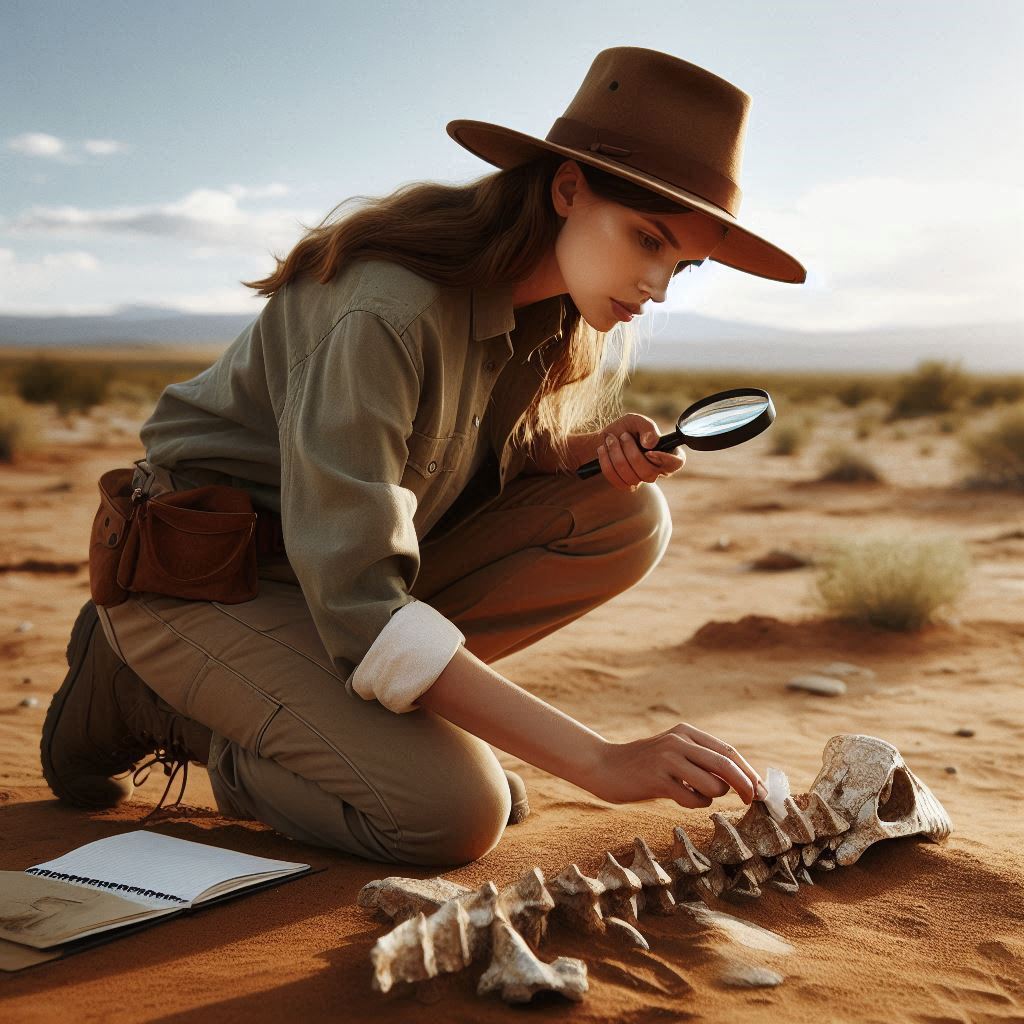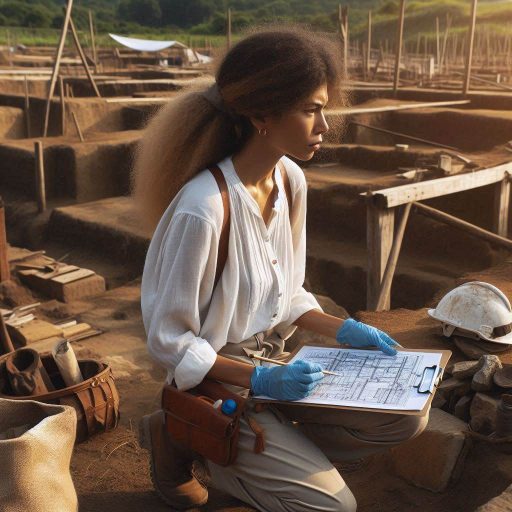Introduction
Archaeology thrives on its interdisciplinary nature, blending various fields to enrich our understanding of the past.
This blend of disciplines enhances research quality and expands the scope of discoveries.
Fields such as history, anthropology, geology, and art history contribute unique perspectives, allowing archaeologists to uncover deeper insights about ancient cultures and civilizations.
By integrating methodologies and techniques from these diverse areas, archaeologists can analyze artifacts, study ancient environments, and interpret cultural practices more effectively.
As we move forward, embracing interdisciplinary methodologies becomes essential for advancing archaeological knowledge.
Engaging experts from various disciplines fosters innovative research and encourages creative problem-solving.
Collaboration allows archaeologists to tackle complex questions that a single discipline might not fully address.
For instance, collaboration with geologists can reveal insights into past climates, while anthropologists can provide context for social structures within ancient communities.
Institutions and universities should promote partnerships between archaeologists and specialists in related fields.
These collaborations can lead to groundbreaking discoveries and a more comprehensive understanding of human history.
Furthermore, funding agencies must support interdisciplinary projects that encourage joint research initiatives.
By investing in these partnerships, we can enhance research outcomes and ensure a holistic approach to archaeological study.
The Importance of Interdisciplinary Approaches in Archaeology
Explanation of How Archaeology Combines Various Disciplines
Archaeology thrives on interdisciplinary approaches.
It integrates various fields like anthropology, history, geography, and environmental science.
This blend enriches our understanding of past human behaviors and societies.
Each discipline contributes unique perspectives, enhancing archaeological research and findings.
Anthropology plays a crucial role in archaeology.
It helps archaeologists understand cultural practices and social structures.
Anthropologists study how ancient peoples lived, interacted, and adapted to their environments.
Their insights inform interpretations of artifacts and settlement patterns.
For instance, studying burial practices reveals beliefs about life and death in ancient cultures.
History complements archaeology by providing context.
Historical texts offer valuable information about past events and civilizations.
Archaeologists often cross-reference these texts with material remains.
This practice helps verify and expand historical narratives.
For example, discovering an ancient city mentioned in historical records can confirm its significance and provide new insights.
Geography significantly influences archaeological work.
It examines how the physical landscape affects human activity.
Geographic information systems (GIS) allow researchers to analyze spatial data effectively.
GIS helps map archaeological sites, revealing patterns of settlement and resource use.
By understanding geographical factors, archaeologists can explain how environments shaped human behavior.
Environmental science contributes to archaeology by analyzing ancient ecosystems.
It studies climate change and its impact on human societies.
For example, examining pollen samples from archaeological sites helps reconstruct past environments.
This information can explain how climate fluctuations influenced migration and settlement patterns.
How Interdisciplinary Approaches Enhance Archaeological Research and Findings
The integration of these disciplines leads to more comprehensive findings.
A well-rounded archaeological investigation often requires collaboration among specialists.
Archaeologists may work with geologists to date artifacts accurately.
They may also collaborate with botanists to identify plant remains.
Such partnerships enhance the depth and accuracy of archaeological research.
Interdisciplinary approaches foster innovative methodologies.
For example, advances in technology have transformed archaeological practices.
Techniques like radiocarbon dating and DNA analysis rely on scientific disciplines.
These methods provide precise information about artifacts and human remains.
They also reveal connections between ancient peoples and modern populations.
Furthermore, interdisciplinary research can address contemporary issues.
Archaeology can inform discussions about cultural heritage and preservation.
By understanding the past, societies can make informed decisions about future actions.
This awareness fosters respect for diverse cultures and histories.
Interdisciplinary approaches are vital in archaeology.
They enrich research by incorporating various fields of study.
By combining perspectives from anthropology, history, geography, and environmental science, archaeologists uncover deeper insights.
These collaborations enhance our understanding of the complex tapestry of human history.
Ultimately, they allow us to appreciate the intricate connections between people and their environments over time.
Collaboration with Scientists in Archaeological Work
How Archaeologists Work with Scientists
Collaboration between archaeologists and scientists is crucial for advancing archaeological research.
Archaeologists often partner with geologists, botanists, chemists, and other specialists.
This teamwork enhances the understanding of ancient artifacts and sites.
Each scientific discipline brings unique tools and methodologies to archaeological investigations.
Geologists help archaeologists understand the physical context of sites.
They analyze soil composition, sediment layers, and geological formations.
By studying the geological context, geologists provide insights into past environmental conditions.
For instance, they can determine how natural processes shaped landscapes over time.
This information aids in interpreting the archaeological record.
Botanists also play a vital role in archaeological research.
They study ancient plant remains to reconstruct past environments.
Analyzing pollen, seeds, and other plant materials reveals information about ancient diets and agricultural practices.
For example, identifying the types of crops grown by ancient peoples helps understand their subsistence strategies.
Such insights can highlight the relationship between humans and their environment.
Chemists contribute to archaeology through scientific analysis of materials.
They examine the chemical composition of artifacts, such as pottery and metals.
This analysis helps identify production techniques and trade networks.
For example, determining the chemical makeup of pottery can indicate its origin.
This information sheds light on ancient trade routes and cultural exchanges.
Examples of How Scientific Methods Contribute to Understanding Ancient Artifacts and Sites
Scientific methods enhance archaeological findings in various ways.
One notable example is radiocarbon dating, which relies on chemistry to determine the age of organic materials.
This technique allows archaeologists to establish timelines for human activity.
Accurate dating helps contextualize artifacts within specific historical periods.
Another example is the use of remote sensing technology, which combines geology and engineering.
Techniques like ground-penetrating radar (GPR) and LiDAR enable archaeologists to survey large areas.
These methods reveal hidden structures without invasive excavation.
For instance, GPR can detect buried walls and features, guiding excavations more effectively.
DNA analysis also exemplifies collaboration between archaeologists and scientists.
By extracting DNA from ancient remains, researchers can uncover information about past populations.
This analysis helps reconstruct migration patterns and genetic relationships.
For instance, studies of ancient human DNA have revealed connections between populations across vast distances.
Furthermore, isotopic analysis provides insights into ancient diets and mobility.
By examining isotopes in human remains, scientists can determine what individuals ate and where they lived.
This method can identify shifts in diet due to environmental changes or cultural practices.
In summary, collaboration with scientists enriches archaeological research.
By working with geologists, botanists, chemists, and other specialists, archaeologists gain valuable insights into ancient artifacts and sites.
Scientific methods contribute to accurate dating, understanding past environments, and reconstructing human behaviors.
This interdisciplinary approach enhances the depth and accuracy of archaeological findings, ultimately expanding our knowledge of human history.
Read: Interdisciplinary Research: Botany and Other Sciences
Use of Technology in Archaeological Studies
How Technology Is Used in Archaeological Research
Technology plays a pivotal role in modern archaeological studies.
It enhances the methods used to survey, analyze, and interpret archaeological data.
Tools such as Geographic Information Systems (GIS), remote sensing, and 3D modeling have transformed the field.
These technologies allow archaeologists to explore sites more efficiently and accurately.
GIS mapping is one of the most valuable technological advancements in archaeology.
It enables researchers to visualize spatial relationships among artifacts and features.
By overlaying various data layers, such as topography and land use, archaeologists can identify patterns.
For example, GIS can reveal how ancient settlements relate to natural resources.
This spatial analysis enhances understanding of how ancient peoples interacted with their environment.
Remote sensing technologies, such as satellite imagery and LiDAR (Light Detection and Ranging), provide another powerful tool.
These methods allow archaeologists to survey large areas without disturbing the ground.
LiDAR can penetrate vegetation to reveal underlying structures.
For instance, it has uncovered ancient Maya cities hidden in dense jungles.
This non-invasive approach saves time and resources while revealing significant archaeological features.
3D modeling is also revolutionizing archaeological research.
This technology allows for the detailed reconstruction of artifacts and sites.
By creating digital replicas, archaeologists can analyze objects from various angles.
For example, 3D models can aid in studying wear patterns on tools, offering insights into their use.
This technique also facilitates virtual exhibitions, making artifacts accessible to a wider audience.
Benefits of Using Technology to Analyze and Interpret Archaeological Data
The benefits of using technology in archaeology are numerous.
First, it increases efficiency in data collection and analysis.
Technologies like GIS streamline the process of mapping sites, saving valuable time.
Archaeologists can focus on interpretation rather than manual data entry.
Second, technology enhances accuracy in archaeological research.
Remote sensing methods provide precise information about site features.
This accuracy reduces the likelihood of missing important artifacts during excavation.
As a result, archaeologists can make more informed decisions based on reliable data.
Third, technology facilitates collaboration among researchers.
Digital tools allow for the sharing of data and findings across disciplines and geographic locations.
Online platforms enable archaeologists to collaborate with scientists and experts worldwide.
This collaboration fosters a more holistic approach to understanding the past.
Additionally, technology aids in preserving cultural heritage.
Digital documentation techniques, such as 3D scanning, create permanent records of artifacts.
These records help protect against loss or damage.
In cases of looting or natural disasters, digital archives can aid in restoration efforts.
Lastly, technology improves public engagement with archaeology.
Virtual reality and interactive exhibits allow the public to experience archaeological sites remotely.
These technologies increase awareness and appreciation for cultural heritage.
By engaging the public, archaeologists can advocate for the preservation of historical sites.
Technology significantly impacts archaeological studies.
GIS mapping, remote sensing, and 3D modeling enhance data collection and interpretation.
The benefits include increased efficiency, accuracy, collaboration, preservation, and public engagement.
As technology continues to evolve, it will further enrich our understanding of ancient societies and their cultural legacies.
Read: Women in Botany: Celebrating Pioneers and Leaders
Ethical Considerations in Interdisciplinary Archaeological Work
Ethical Issues Related to Collaborations Between Archaeologists and Other Disciplines
Interdisciplinary collaborations in archaeology raise several ethical considerations.
When archaeologists work with scientists from other fields, they must navigate issues of ownership and authority.
Each discipline has its own set of ethical standards and practices, which can lead to conflicts.
For instance, the methods and interpretations favored by one discipline may overshadow those of another.
This imbalance can result in the marginalization of archaeological perspectives in favor of scientific ones.
Moreover, interdisciplinary projects may involve sensitive data and cultural artifacts.
Archaeologists must be cautious about how this information is shared and utilized.
Issues of consent arise, particularly when working with indigenous communities.
Researchers must ensure that they respect the wishes of these communities regarding their cultural heritage.
Failure to do so can lead to exploitation and a loss of trust between researchers and local populations.
Another ethical challenge involves the interpretation of data.
Different disciplines may have varying interpretations of the same findings.
For example, a chemist’s analysis of ancient pottery may yield results that contradict traditional archaeological narratives.
Navigating these differences requires open communication and mutual respect among collaborators.
Ethically, it is essential to honor all perspectives while striving for a comprehensive understanding of the past.
Importance of Respecting Cultural Heritage and Indigenous Knowledge
Respecting cultural heritage is a cornerstone of ethical archaeological practice.
Archaeologists must prioritize the significance of cultural artifacts and sites to indigenous and local communities.
These items are not just historical relics; they embody the values and traditions of living cultures.
Therefore, archaeologists should engage with indigenous peoples to understand their perspectives.
Collaborative efforts ensure that cultural heritage is preserved and represented accurately.
Incorporating indigenous knowledge into interdisciplinary research enriches the archaeological narrative.
Indigenous communities often possess valuable insights about their histories, landscapes, and practices.
Their knowledge can inform archaeological methodologies and interpretations.
For example, traditional ecological knowledge can enhance understandings of ancient agricultural practices.
By valuing this input, researchers can create a more holistic picture of the past.
Ethical interdisciplinary research also involves transparency and accountability.
Archaeologists must be open about their methods, intentions, and findings.
This transparency fosters trust among collaborators and local communities.
Researchers should involve stakeholders in decision-making processes related to archaeological work.
Engaging communities in discussions about their cultural heritage empowers them and affirms their rights.
Furthermore, ethical considerations extend to the preservation of archaeological sites.
Interdisciplinary collaborations can bring valuable resources and expertise, but they also risk overexploitation.
Researchers must prioritize sustainable practices that protect cultural heritage from damage.
This commitment to preservation ensures that future generations can learn from and engage with the past.
Ethical considerations are vital in interdisciplinary archaeological work.
Navigating collaborations between archaeologists and other disciplines requires awareness of potential conflicts and sensitivities.
Respecting cultural heritage and indigenous knowledge is crucial for fostering trust and understanding.
By prioritizing ethical practices, researchers can contribute to a more inclusive and respectful exploration of the past.
Ultimately, these efforts enhance our appreciation for diverse cultural histories and promote responsible stewardship of heritage.
Read: How Climate Change Is Impacting Plant Research

Challenges of Interdisciplinary Archaeological Work
Challenges Faced When Different Disciplines Come Together
Interdisciplinary archaeological work presents unique challenges that can hinder collaboration.
One major challenge is the difference in terminology and methodologies among disciplines.
Each field has its own language, which can lead to misunderstandings.
For instance, archaeologists and scientists may interpret the same data differently due to their distinct approaches.
This divergence can create friction and complicate joint efforts.
Another significant challenge is the varying priorities and goals of different disciplines.
Archaeologists may focus on cultural contexts, while scientists might prioritize technical data.
These differing objectives can lead to conflicts regarding project direction and outcomes.
If team members do not share a unified vision, the effectiveness of the collaboration may suffer.
Additionally, time constraints can pose challenges in interdisciplinary projects.
Each discipline often operates on its own timeline, which may not align with others.
Archaeological fieldwork might require immediate attention, while scientific analyses may take longer to complete.
This mismatch can create frustration and hinder progress.
Resource allocation also becomes a challenge in interdisciplinary work.
Different disciplines may have varying budgets and funding sources, making it difficult to manage finances collectively.
Unequal resource distribution can lead to disparities in project contributions and outcomes.
Addressing these issues requires careful planning and negotiation among team members.
Strategies for Overcoming Barriers and Fostering Successful Collaborations
Despite these challenges, there are strategies to foster successful interdisciplinary collaborations in archaeology.
First, establishing clear communication from the beginning is crucial.
Team members should openly discuss their expectations, goals, and methodologies.
Regular meetings can help maintain alignment and address misunderstandings promptly.
By fostering an environment of open dialogue, teams can bridge gaps in understanding.
Second, creating a shared framework for collaboration can enhance cohesion.
Defining roles and responsibilities early on ensures that each discipline’s contributions are recognized and valued.
This framework can include common goals, timelines, and methodologies that accommodate the needs of all participants.
By establishing a unified plan, teams can navigate potential conflicts more effectively.
Third, promoting mutual respect and understanding among team members is essential.
Encouraging collaboration between archaeologists and scientists allows them to learn from one another.
Workshops or training sessions can facilitate knowledge exchange and help team members appreciate each other’s expertise.
This mutual respect fosters a positive working environment and strengthens collaboration.
Fourth, employing technology can enhance interdisciplinary work.
Tools such as project management software can help streamline communication and resource sharing.
Collaborative platforms allow team members to access shared data and findings in real time.
By utilizing technology, teams can improve coordination and minimize potential delays.
Finally, flexibility is key in overcoming barriers.
Team members should be willing to adapt their approaches and methodologies as needed.
Recognizing that interdisciplinary work requires compromise can foster a more collaborative spirit.
This flexibility allows teams to navigate challenges and find innovative solutions together.
Interdisciplinary archaeological work presents challenges but also offers significant opportunities for discovery.
By addressing communication barriers, establishing a shared framework, promoting respect, utilizing technology, and maintaining flexibility, teams can foster successful collaborations.
These strategies enable archaeologists and scientists to work together effectively, enhancing the understanding of our shared human history.
Ultimately, interdisciplinary efforts contribute to a more comprehensive exploration of the past and its relevance to the present.
Read: Exploring the Different Branches of Geology
Learn More: Women in Meteorology: Breaking Barriers and Succeeding
Case Studies of Successful Interdisciplinary Archaeological Projects
Examples of Archaeological Projects That Have Successfully Integrated Interdisciplinary Approaches
Several archaeological projects have effectively integrated interdisciplinary approaches, leading to groundbreaking discoveries.
One notable example is the “Hominin Sites and Paleolakes Drilling Project” in East Africa.
This project combines archaeology, geology, and paleoecology to understand human evolution.
Researchers collected sediment cores from ancient lake beds to analyze environmental changes.
By integrating paleoclimatic data with archaeological evidence, they gained insights into how ancient hominins adapted to their environment.
This collaboration enhanced our understanding of the link between climate change and human evolution.
Another successful interdisciplinary project is the “Maya Site Mapping Project” in Guatemala.
Archaeologists collaborated with remote sensing specialists to map ancient Maya cities hidden beneath dense jungle.
Using LiDAR technology, the team discovered previously unknown structures, including pyramids and road systems.
This project illustrates how combining archaeology with advanced technology can uncover significant archaeological features.
The findings have reshaped our understanding of Maya urban planning and social organization.
The “Maritime Archaeology Project” on the Great Lakes is another example.
This initiative integrates archaeology, marine biology, and history to study shipwrecks and underwater landscapes.
Researchers analyze artifacts, ship construction, and the ecological impact of maritime activities.
By employing diverse methods, they reconstruct historical trade routes and understand the cultural significance of shipwrecks.
This interdisciplinary approach has enriched our knowledge of Great Lakes history and the people who navigated its waters.
The Impact of These Projects on Our Understanding of the Past
These interdisciplinary projects significantly impact our understanding of the past.
By combining diverse expertise, researchers can tackle complex questions that single disciplines might overlook.
For instance, the Hominin Sites and Paleolakes Drilling Project highlights how environmental factors influenced human evolution.
The collaboration between geologists and archaeologists provided a more nuanced understanding of hominin behavior in response to climate changes.
The Maya Site Mapping Project has transformed perceptions of Maya civilization.
The integration of LiDAR technology revealed the extent and complexity of urban planning.
These discoveries challenge previous assumptions about the size and organization of Maya cities.
They demonstrate that the Maya had sophisticated infrastructures that supported large populations.
This project reshapes our understanding of the socio-political dynamics within ancient Maya society.
In the Great Lakes project, the combination of archaeology and marine biology offers a holistic view of maritime history.
Researchers can understand the relationships between human activities and aquatic environments.
By examining shipwrecks, they gain insights into trade, navigation, and cultural exchanges.
This interdisciplinary work emphasizes the importance of understanding human interactions with ecosystems throughout history.
Furthermore, successful interdisciplinary projects encourage collaboration among researchers from different fields.
They foster a culture of sharing knowledge and methodologies, which can lead to innovative solutions.
As these projects continue to evolve, they inspire future research endeavors that prioritize interdisciplinary approaches.
Case studies of successful interdisciplinary archaeological projects demonstrate the value of collaboration.
The integration of diverse disciplines enhances our understanding of the past and uncovers new insights.
By combining expertise from archaeology, geology, technology, and other fields, researchers can address complex historical questions.
These projects highlight the richness of human history and the importance of interdisciplinary approaches in archaeological research.
Ultimately, they pave the way for future discoveries and a deeper appreciation of our shared heritage.
Training and Education for Interdisciplinary Archaeological Work
The Training and Education Needed for Archaeologists to Work Effectively with Other Disciplines
To thrive in interdisciplinary archaeological work, training and education must focus on developing diverse skills.
Archaeologists need a solid foundation in their discipline while also acquiring knowledge from related fields.
This well-rounded education prepares them to engage effectively with scientists, historians, and other professionals.
Many archaeological programs now incorporate interdisciplinary coursework.
For instance, courses in anthropology, history, geography, and environmental science provide essential context for archaeological studies.
Understanding the principles of these disciplines allows archaeologists to collaborate more effectively.
They can appreciate how different perspectives enhance research outcomes.
Moreover, practical training opportunities play a crucial role in interdisciplinary education.
Fieldwork experiences should include collaborations with scientists, geologists, and botanists.
These hands-on experiences enable students to apply their knowledge in real-world scenarios.
By working alongside experts from various fields, they learn to integrate multiple perspectives into their archaeological practice.
Professional development programs can also help archaeologists acquire interdisciplinary skills.
Workshops, conferences, and seminars focused on interdisciplinary collaboration can enhance researchers‘ abilities.
These opportunities encourage networking and sharing of best practices among disciplines.
As archaeologists gain exposure to different methodologies, they become more versatile in their approaches.
Importance of Developing Interdisciplinary Skills and Knowledge in Archaeological Programs
Developing interdisciplinary skills and knowledge is crucial for the future of archaeology.
The complexity of archaeological research often requires insights from multiple disciplines.
By fostering a broad skill set, programs can prepare students for the challenges they will face in the field.
This preparation is essential as archaeological questions become increasingly intricate and interconnected.
Interdisciplinary skills enhance researchers‘ ability to tackle pressing global issues.
Climate change, migration, and cultural heritage preservation are examples of challenges that benefit from interdisciplinary approaches.
Archaeologists equipped with knowledge from other fields can contribute valuable insights into these pressing issues.
Their diverse perspectives can inform policies and practices that address contemporary challenges.
Furthermore, interdisciplinary training fosters innovation in archaeological research.
Exposure to different methodologies encourages creative problem-solving.
Students learn to think critically about their research questions and explore new avenues of inquiry.
This flexibility leads to more comprehensive research outcomes and richer understandings of the past.
Finally, developing interdisciplinary skills promotes collaboration within the academic and research communities.
As archaeologists become adept at working with other disciplines, they can build stronger networks.
These connections can lead to fruitful collaborations on future projects, enhancing research quality and impact.
Training and education are vital for effective interdisciplinary archaeological work.
By incorporating diverse disciplines into their programs, educational institutions can equip future archaeologists with essential skills.
Interdisciplinary training enhances researchers’ ability to tackle complex questions and contribute to contemporary issues.
Ultimately, fostering interdisciplinary collaboration enriches archaeological research and broadens our understanding of the past.
Transform Your Career Today
Unlock a personalized career strategy that drives real results. Get tailored advice and a roadmap designed just for you.
Start NowDelve into the Subject: How Toxicologists Contribute to Public Health Safety
Conclusion
Archaeological work relies heavily on the collaboration of multiple disciplines, showcasing its truly interdisciplinary nature.
It‘s not just about uncovering artifacts; it‘s about combining the expertise of various fields to fully understand the past.
Archaeologists work alongside anthropologists, geologists, chemists, and even engineers to gather a comprehensive view of ancient civilizations.
Anthropology helps interpret the social and cultural significance of findings, while geology aids in understanding the landscape and environmental factors that shaped human development.
Chemistry is used to date artifacts and analyze materials, while technology from engineering assists in excavation and site preservation.
This interdisciplinary synergy enables a more holistic approach to archaeological research, revealing intricate details that one field alone might miss.
Without collaboration, the full context of archaeological discoveries could be lost or misunderstood.
The future of archaeology lies in continuing this integrated approach.
Scholars, researchers, and students should actively seek opportunities for interdisciplinary collaboration and research to push the field forward.
By working together, we can unlock new dimensions of human history and ensure that our understanding of the past becomes even more complete.
[E-Books for Sale]
The Big Book of 500 High-Paying Jobs in America: Unlock Your Earning Potential
$19.99 • 500 High-Paying Jobs • 330 pages
Explore 500 high-paying jobs in America and learn how to boost your career, earn more, and achieve success!
See All 500 High-Paying Jobs of this E-Book
1001 Professions Without a Degree: High-Paying American Jobs You Can Start Now
$19.99 • 1001 Professions Without a Degree • 174 pages
Discover 1001 high-paying jobs without a degree! Unlock career tips, skills, and success strategies for just $19.99!




